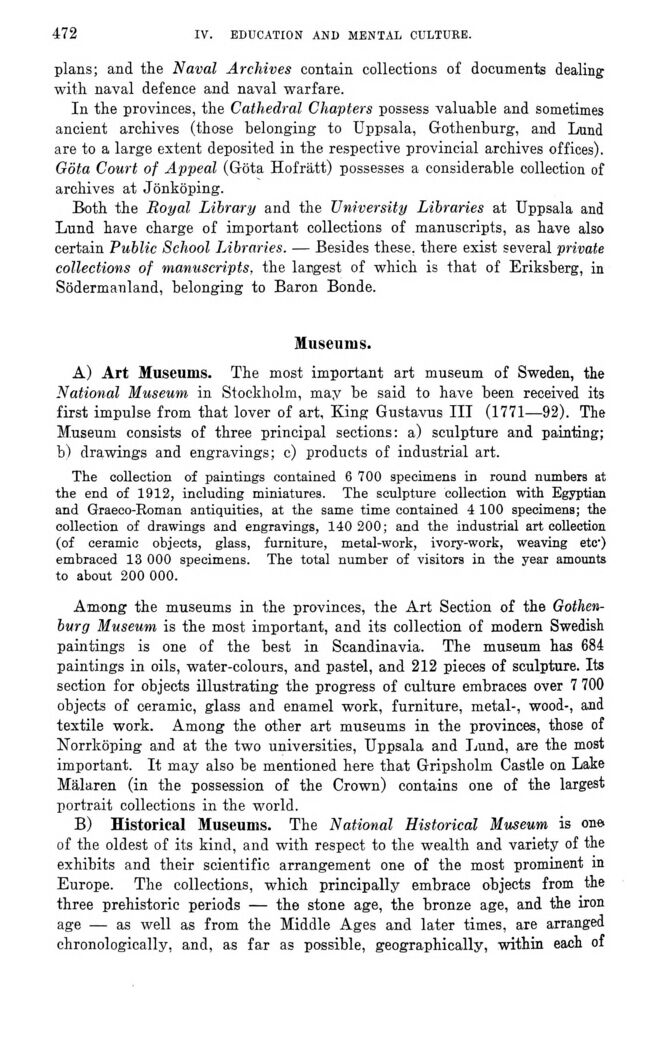
Full resolution (JPEG) - On this page / på denna sida - IV. Education and Mental Culture. Introd. by P. E. Lindström - 8. Public Collections and Institutions for Science and Art. The Periodial Press - Archives. By E. Hildebrand - Museums. By [B. Lundstedt], L. Looström and A. Gauffin

<< prev. page << föreg. sida << >> nästa sida >> next page >>
Below is the raw OCR text
from the above scanned image.
Do you see an error? Proofread the page now!
Här nedan syns maskintolkade texten från faksimilbilden ovan.
Ser du något fel? Korrekturläs sidan nu!
This page has never been proofread. / Denna sida har aldrig korrekturlästs.
48(5
iv. education and mental culture.
plans; and the Naval Archives contain collections of documents dealing
with naval defence and naval warfare.
In the provinces, the Cathedral Chapters possess valuable and sometimes
ancient archives (those belonging to Uppsala, Gothenburg, and Lund
are to a large extent deposited in the respective provincial archives offices).
Göta Court of Appeal (Göta Hofrätt) possesses a considerable collection of
archives at Jönköping.
Both the Royal Library and the University Libraries at Uppsala and
Lund have charge of important collections of manuscripts, as have also
certain Public School Libraries. — Besides these, there exist several private
collections of manuscripts, the largest of which is that of Eriksberg, in
Södermanland, belonging to Baron Bonde.
Museums.
A) Art Museums. The most important art museum of Sweden, the
National Museum in Stockholm, may be said to have been received its
first impulse from that lover of art, King Gustavus III (1771—92). The
Museum consists of three principal sections: a) sculpture and painting;
b) drawings and engravings; c) products of industrial art.
The collection of paintings contained 6 700 specimens in round numbers at
the end of 1912, including miniatures. The sculpture collection with Egyptian
and Graeco-Roman antiquities, at the same time contained 4 100 specimens; the
collection of drawings and engravings, 140 200; and the industrial art collection
(of ceramic objects, glass, furniture, metal-work, ivory-work, weaving etc’)
embraced 13 000 specimens. The total number of visitors in the year amounts
to about 200 000.
Among the museums in the provinces, the Art Section of the
Gothenburg Museum is the most important, and its collection of modern Swedish
paintings is one of the best in Scandinavia. The museum has 684
paintings in oils, water-colours, and pastel, and 212 pieces of sculpture. Its
section for objects illustrating the progress of culture embraces over 7 700
objects of ceramic, glass and enamel work, furniture, metal-, wood-, and
textile work. Among the other art museums in the provinces, those of
Norrköping and at the two universities, Uppsala and Lund, are the most
important. It may also be mentioned here that Gripsholm Castle on Lake
Mälaren (in the possession of the Crown) contains one of the largest
portrait collections in the world.
B) Historical Museums. The National Historical Museum is one
of the oldest of its kind, and with respect to the wealth and variety of the
exhibits and their scientific arrangement one of the most prominent in
Europe. The collections, which principally embrace objects from the
three prehistoric periods — the stone age, the bronze age, and the iron
age — as well as from the Middle Ages and later times, are arranged
chronologically, and, as far as possible, geographically, within each of
<< prev. page << föreg. sida << >> nästa sida >> next page >>